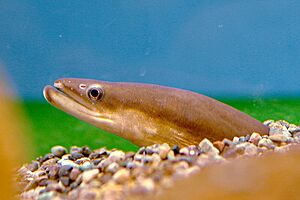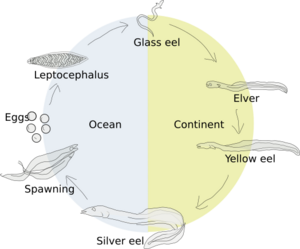Japanese eel facts for kids
Quick facts for kids Japanese eel |
|
|---|---|
 |
|
| Conservation status | |
| Scientific classification | |
| Synonyms | |
|
The Japanese eel (Anguilla japonica) is a special type of eel found in countries like Japan, Korea, Taiwan, China, Vietnam, and the northern Philippines. These eels are catadromous, which means they travel from freshwater rivers to the ocean to lay their eggs. Then, their babies travel back to freshwater to grow up.
Japanese eels are very important in Japan's food culture. They are called unagi and are often grilled, a dish known as kabayaki. Most of the eels sold in Japan come from farms. However, the number of Japanese eels in the wild is shrinking. This is because of too much fishing, losing their homes, and changes in ocean conditions. Because of this, the Japanese eel is now an endangered species.
Contents
Eel Reproduction
Japanese eels travel thousands of kilometers to lay their eggs. Between April and November, adult eels leave their freshwater homes in East Asia. They swim all the way to a special area in the western North Pacific Ocean. This area is near the North Equatorial Current. The eels do not eat during this long journey. They use the energy from oils stored in their bodies.
Scientists discovered this breeding spot in 1991. Before that, no one knew where these mysterious eels laid their eggs! In 2005, scientists found an even more exact spot. It is near the Suruga Seamount, west of the Mariana Islands. This area has a special "salinity front," which is like a border between different types of ocean water. This front tells the eels they are in the right place to spawn. The North Equatorial Current then helps the baby eels travel towards Asia.
The baby eels are called leptocephali. They hatch from the eggs about 36 hours after fertilization. These tiny, leaf-shaped larvae grow quickly. They ride the North Equatorial Current and then the Kuroshio Current towards East Asia. Once they reach the coast, they swim into rivers, lakes, and estuaries. They live there until they are adults, then they return to the ocean to lay their own eggs and complete their life cycle.
The Amazing Life Cycle of the Japanese Eel
The Japanese eel goes through five different stages in its life. Each stage has its own special name and look.
- Leptocephalus: This is the first stage after hatching from an egg. These tiny, clear, leaf-shaped larvae float in the open ocean. They eat tiny bits of food called "marine snow."
- Glass Eels: After about 18 months, the leptocephali change into "glass eels." They are called this because they are clear, like glass!
- Elvers: When glass eels reach freshwater rivers and estuaries, they become "elvers." This usually happens between December and April. Elvers are about 6 centimeters (2.4 inches) long. They have a strong instinct to swim upstream, even climbing over small obstacles. They often travel at night to avoid predators.
- Brown-Stage (or Yellow-Stage) Eels: After about two weeks of migrating upstream, elvers turn a darker color, usually grey, brown, or greenish. They are now called brown-stage or yellow-stage eels. They live in rivers and estuaries for 5 to 10 years. During this time, they eat worms and insects. Female eels grow much larger, up to 60 centimeters (24 inches), while males are smaller, around 35 centimeters (14 inches).
- Silver Eels: When eels are ready to return to the ocean to lay eggs, they change into their final stage: silver eels. Their skin turns a shiny silver color. They also store a lot of oil in their bodies, which gives them energy for their long journey. Once they have enough oil, they stop eating. In the autumn, usually around the new moon, they swim downstream and head back to the Pacific Ocean to lay their eggs. After laying their eggs, the adult eels die.
Why Are Japanese Eels Endangered?
The number of Japanese eels in the wild is decreasing. There are several reasons why this is happening.
Threats to Eels
- Climate Change: Eels rely on water temperature to know when to migrate. Rising ocean temperatures make it harder for them to know when to move between freshwater and saltwater. This can mess up their life cycle. Changes in ocean currents and salinity (saltiness) also affect where eels lay their eggs and where their larvae end up. Sometimes, the baby eels are carried to places where they cannot survive.
- Habitat Loss: More and more people are building homes and cities along coastlines and rivers. This takes away the natural places where eels live and grow. From the 1970s to the 2010s, about 76% of the Japanese eel's habitat was lost due to human development.
- Overfishing: Because eels are so popular for food, too many are caught. This is especially true for the young "glass eels" that are caught to be raised on farms.
Eel Status
The IUCN (International Union for Conservation of Nature) has listed the Japanese eel as an endangered species. This means their population is at high risk of disappearing forever. The last time they checked in 2018, the number of eels was still going down.
What's Being Done?
The Japanese government is working to protect these important eels.
- In 2015, the Inland Water Fishery Promotion Act was put in place. This law makes it illegal to fish for or farm eels without a special permit. This helps control how many eels are caught.
- There are also plans for a new law in December 2023. This law will make it a serious crime to catch glass eels without a permit. The punishment could be up to three years in prison or a very large fine.
- Efforts are also being made to restore eel habitats through "Nature-oriented river works." This means making rivers more natural and suitable for eels.
- Another law, the Act on "Ensuring the Proper Domestic Distribution and Importation of Specified Aquatic Animals and Plants," was started in 2020. This law helps make sure that eels are traded legally and responsibly.
Farming Japanese Eels
Farming eels, also called aquaculture, started in Japan in 1894. Japan is now the biggest producer and consumer of eels in the world. They produce about 70-90% of the world's farmed eels.
Farming Japanese eels is tricky because scientists have not yet figured out how to breed them in captivity. This means that eel farms rely on catching young "elvers" from the wild. These elvers are caught in nets as they swim up rivers. Then, they are moved to special ponds where they grow to a commercial size. Most farmed eels are female because they grow much larger than males. While farming helps meet the demand for eels, it also puts pressure on the wild population.
Eels Helping Science
| Bilirubin-inducible green fluorescent protein UnaG | |||||||
|---|---|---|---|---|---|---|---|
| Identifiers | |||||||
| Organism | |||||||
| Symbol | UnaG | ||||||
| UniProt | P0DM59 | ||||||
|
|||||||
The Japanese eel has a unique ability: it can produce a special protein called UnaG. This protein is found in the eel's muscles. UnaG is very useful in science because it can glow green! Scientists can use it to light up cells and tag other proteins. This helps them study how cells work. UnaG has even been used in a test to check how well a person's liver is working.
Eating Japanese Eels
In Japan, the Japanese eel is a popular food called unagi. A common way to prepare it is kabayaki. This is when the eel is cut into fillets, deboned, put on skewers, marinated in a sweet soy sauce (called tare), and then grilled. If it's grilled with just salt, it's called Shirayaki. Eels are eaten all year round in Japan.
Some popular dishes with Japanese eel include:
- Unajū: This is a dish where grilled eel is served over steamed rice in a special lacquered box.
- Unadon: Similar to unajū, but served in a large bowl over rice.
- Unagi sushi: Eel is also used in sushi. Unakyu is sushi with eel and cucumber, and "rock and roll" is a Western-style sushi with eel and avocado.
Japanese eel blood contains a protein toxin that can be harmful to humans. But don't worry! This toxin is destroyed by heat. So, Japanese eels are always cooked before they are eaten, even for sushi. Many sushi restaurants buy pre-cooked eel fillets.
Because there are fewer Japanese eels now, other types of eels, like European or American eels, are sometimes used instead.
Japanese eels are also very healthy! They are a good source of many vitamins and minerals. A 100-gram serving can give you a lot of vitamin B12, vitamin D, and vitamin A. They also have vitamins like B1, B2, and E. You can also find minerals like phosphorus, selenium, zinc, and potassium in them. Eels are also rich in protein and have some healthy omega-3 fatty acids. They also have very low levels of mercury.
Images for kids








